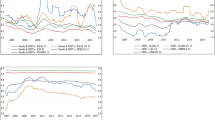Abstract
This paper examines the interaction between investment and financing decisions of a firm using a real options approach. The firm is endowed with a perpetual option to invest in a project at any time by incurring an irreversible investment cost at that instant. The amount of the irreversible investment cost is directly related to the intensity of investment that is endogenously chosen by the firm. At the investment instant, the firm can finance the project by issuing debt and equity, albeit subject to an exogenously given credit constraint that prohibits the firm’s debt-to-asset ratio from exceeding a prespecified threshold. The optimal capital structure of the firm is determined by the trade-off between interest tax-shield benefits and bankruptcy costs of debt. Irrespective of whether the exogenously given credit constraint is binding or not, we show that leverage has no impact on the firm’s optimal investment intensity, thereby rendering the neutrality of debt in investment intensity. Similar to earlier work, we show that debt is not neutral to investment timing in general, and the levered firm invests earlier than the unlevered firm in particular.
Similar content being viewed by others
References
Abel A.B., Dixit A.K., Eberly J.C., Pindyck R.S.: Options, the value of capital, and investment. Q J Econ 111, 753–777 (1996)
Bar-Ilan A., Strange W.C.: The timing and intensity of investment. J Macroecon 21, 57–77 (1999)
Belhaj, M., Djembissi, B.: Optimal investment under credit constraint. Les Annales d’Economie et de Statistique (2007) (forthcoming)
Brennan M.J., Schwartz E.S.: Corporate income taxes, valuation, and the problem of optimal capital structure. J Bus 51, 103–114 (1978)
Capozza D.R., Li Y.: The intensity and timing of investment: the case of land. Am Econ Rev 84, 889–904 (1994)
Capozza D.R., Li Y.: Optimal land development decisions. J Urban Econ 51, 123–142 (2002)
Childs P.D., Mauer D.C., Ott S.H.: Interactions of corporate financing and investment decisions: the effects of agency conflicts. J Financial Econ 76, 667–690 (2005)
Dammon R.M., Senbet L.W.: The effect of taxes and depreciation on corporate investment and financial leverage. J Finance 43, 357–373 (1988)
Décamps J.-P., Djembissi B.: Switching to a poor business activity: optimal capital structure, agency costs and covenant rules. Ann Finance 3, 389–409 (2007)
Dixit A.K., Pindyck R.S.: Investment Under Uncertainty. Princeton University Press, Princeton, NJ (1994)
Dotan A., Ravid S.A.: On the interaction of real and financial decisions of the firm under uncertainty. J Finance 40, 501–517 (1985)
Goldstein R., Ju N., Leland H.E.: An EBIT-based model of dynamic capital structure. J Bus 74, 483–512 (2001)
Jensen M.C., Meckling W.H.: Theory of the firm: managerial behavior, agency costs and ownership structure. J Financial Econ 3, 305–360 (1976)
Karatzas I., Shreve S.E.: Brownian Motion and Stochastic Calculus. Berlin, Germany: Springer (1988)
Leland H.E.: Corporate debt value, bond covenants, and optimal capital structure. J Finance 49, 1213–1252 (1994)
Mauer D.C., Sarkar S.: Real options, agency conflicts, and optimal capital structure. J Banking Finance 29, 1405–1428 (2005)
Mauer D.C., Triantis A.J.: Interactions of corporate financing and investment decisions: a dynamic framework. J Finance 49, 1253–1277 (1994)
McDonald R., Siegel D.: The value of waiting to invest. Q J Econ 101, 707–727 (1986)
Mello A.S., Parsons J.E.: Measuring the agency cost of debt. J Finance 47, 1887–1904 (1992)
Modigliani F., Miller M.H.: The cost of capital, corporation finance and the theory of investment. Am Econ Rev 48, 261–297 (1958)
Morellec E.: Asset liquidity, capital structure, and secured debt. J Financial Econ 61, 173–206 (2001)
Pindyck R.S.: Irreversible investment, capacity choice, and the value of the firm. Am Econ Rev 78, 969–985 (1988)
Pindyck R.S.: Irreversibility, uncertainty, and investment. J Econ Liter 29, 1110–1148 (1991)
Sabarwal T.: The non-neutrality of debt in investment timing: a new NPV rule. Ann Finance 1, 433–445 (2005)
Sarkar S.: On the investment-uncertainty relationship in a real options model. J Econ Dyn Control 24, 219–225 (2000)
Sarkar S.: The effect of mean reversion on investment under uncertainty. J Econ Dyn Control 28, 377–396 (2003)
Sarkar S.: Can tax convexity be ignored in corporate financing decisions?. J Banking Finance 32, 1310–1321 (2008)
Sarkar S., Zapatero F.: The trade-off model with mean reverting earnings: theory and empirical tests. Econ J 113, 834–860 (2003)
Shackleton M.B., Wojakowski R.: The expected return and exercise time of Merton-style real options. J Bus Finance Account 29, 541–555 (2002)
Strebulaev I.A.: Do tests of capital structure theory mean what they say?. J Finance 62, 1747–1787 (2007)
Thijssen, J.J.J.: Irreversible investment and discounting: an arbitrage pricing approach. Ann Finance 5, in press (2009)
Tserlukevich Y.: Can real options explain financing behavior?. J Financial Econ 89, 232–252 (2008)
Wong K.P.: The effect of uncertainty on investment timing in a real options model. J Econ Dyn Control 31, 2152–2167 (2007)
Wong K.P.: Does market demand volatility facilitate collusion?. Econ Model 25, 696–703 (2008)
Wong, K.P.: The effects of irreversibility on the timing and intensity of lumpy investment. Econ Model 26, in press (2009)
Wong, K.P., Wu, Y.: Tax convexity, investment, and capital structure. Working Paper, University of Hong Kong (2009)
Author information
Authors and Affiliations
Corresponding author
Rights and permissions
About this article
Cite this article
Wong, K.P. On the neutrality of debt in investment intensity. Ann Finance 6, 335–356 (2010). https://doi.org/10.1007/s10436-009-0137-7
Received:
Accepted:
Published:
Issue Date:
DOI: https://doi.org/10.1007/s10436-009-0137-7




